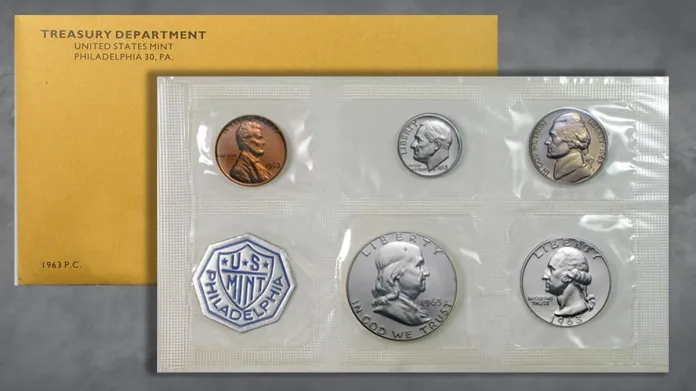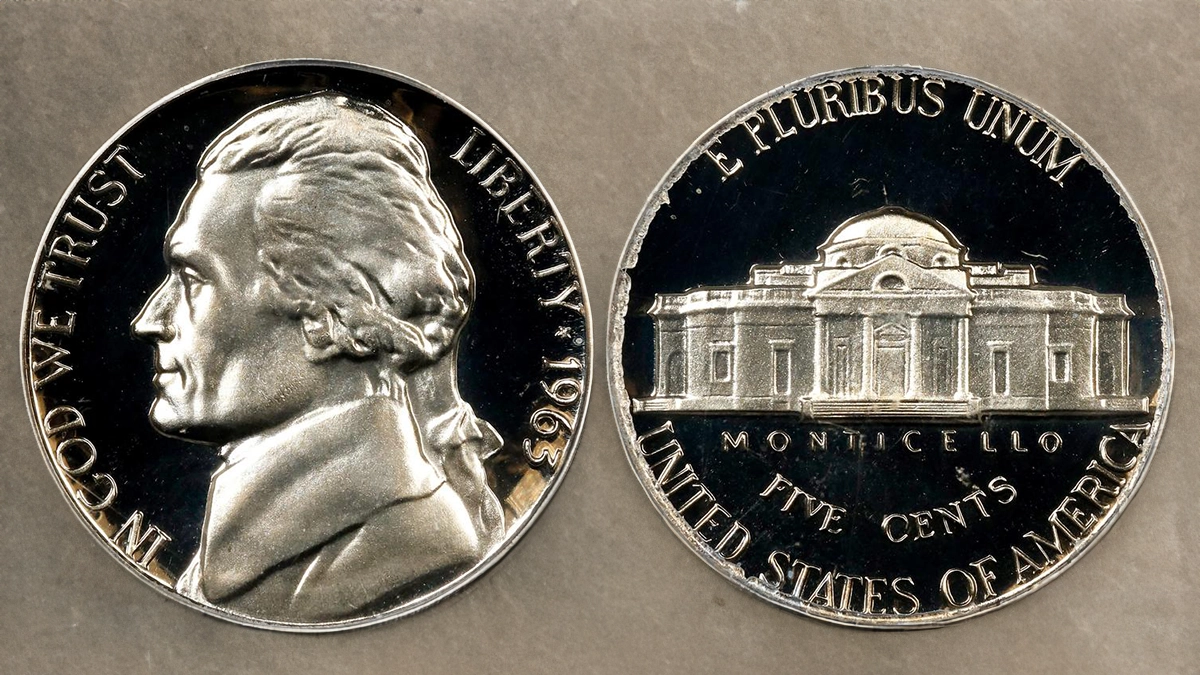
By Charles Morgan and Hubert Walker for CoinWeek Notes …..
Like the other Proof coins issued that year, the 1963 Jefferson Nickel Proof is best understood in the context of the United States Mint’s annual Proof Set and the nation’s imminent switch to copper-nickel clad for most of its minor coinage. Interest in the Proof Set had reached record levels in the 1960s, and just as the Mint could not keep up with the need for circulating coins, its ability to meet the demand for collectible products like Proof Sets was tested with orders exceeding three million units.

The 1963 Proof Set contained one Proof example of each of the five denominations struck that year. Two of them, the 1963 Lincoln Cent Proof and the 1963 Jefferson Nickel Proof, consist of base metals, and the other three, the 1963 Roosevelt Dime Proof, 1963 Washington Quarter Proof, and 1963 Franklin Half Dollar Proof, were the second-to-last 90% silver coins struck before the Coinage Act of 1965 removed silver from our circulating coinage. This set is also notable as the 1963 is the last Franklin Half Dollar Proof issue.
Each coin in the 1963 Proof Set was struck and handled carefully using specially prepared dies and blanks. The quality of the 1963 Jefferson Nickel issued in the 1963 Proof Set was typically high, with a significant minority of pieces displaying sufficient cameo frosting to earn Cameo or Deep Cameo/Ultra Cameo designations by the two major grading services.
Coins with Deep Cameo sell for a higher premium than coins that are fully brilliant or have light Cameo frost.
What Is the 1963 Jefferson Nickel Proof Worth?
The United States Mint sold 3,075,645 1963 Proof Sets, and despite the sets now being over 60 years old, they remain readily available intact. Certain issues are likely to develop on coins that have been stored improperly over time, and to a certain degree, the Proof Set’s Pliofilm packaging will break down. For many coins that have been disturbed by environmental exposure, a thin haze may develop on the coin’s surfaces. This can be removed using non-abrasive chemicals, but any such treatment should be conservative and done by experienced individuals.
The copper-nickel composition of the Jefferson Nickel makes toning an inevitability. Typically, nickels will exhibit a champagne or cognac color over time, but some develop an ice or electric blue hue. An uncommon but not rare result, blue nickels are eye-catching and often sell for a little bit more.
Expect to pay $25 to $30 for an intact 1963 Proof Set, $2 for a 1963 Jefferson Nickel Proof in its raw form, and between $10 and $15 for an example graded Proof 68 or Proof 69. The highest valued widely collectible grade of the 1963 Jefferson Nickel Proof is Proof 69 Deep Cameo/Ultra Cameo. These sell for about $250, and the total number of qualifying coins available in unsubmitted sets is not known. We expect hundreds or even thousands of new coins could be added to the census in upcoming years.
We have not tracked the sole PCGS PR70DCAM coin to a public auction and do not know its certification number.
* * *
Market Data and Noteworthy Specimens
Top Population: PCGS PR70DCAM (1, 10/2024), NGC PF69UCAM (78, 10/2024), and CAC PR67 (1, 10/2024).
- PCGS PR69DCAM #71777330: Stack’s Bowers, April 12, 2023, Lot 91330 – $240.
- PCGS PR69DCAM #70003931: “The George ‘Buddy’ Byers Collection of Jefferson Nickels,” Stack’s Bowers, August 16, 2021, Lot 2156 – $264.
- PCGS PR69DCAM #13372025: “The MKJ Collection, Part II,” Heritage Auctions, June 8, 2013 – $763.75; “The George ‘Buddy’ Byers Collection of Jefferson Nickels,” Stack’s Bowers, August 16, 2021, Lot 2155 – $504.
- PCGS PR69DCAM #13372028: Heritage Auctions, September 28, 2013, Lot 7564 – $822.50.
- PCGS PR69DCAM #13372030: “The GeoHan II PCGS Registry Set,” Heritage Auctions, July 13, 2013, Lot 7550 – $881.25.
* * *
Design
Obverse:
A left-facing bust of President Thomas Jefferson, including a colonial-era pigtail and strikingly similar in detail to the profile of Jean-Antoine Houdon’s 1789 bust, takes up most of the obverse. The top of his head almost touches the rim, and the barest of truncations is visible at the bottom where Jefferson’s left shoulder meets the edge of the coin. The motto IN GOD WE TRUST arcs clockwise along most of the length of the left side of the coin, starting from Jefferson’s chest and extending to his hairline. The word LIBERTY and the date 1963 run clockwise along the right side behind Jefferson. A small five-pointed star divides the two inscriptions.
Reverse:
The reverse features a front view of Monticello, Jefferson’s mansion near Charlottesville, Virginia. The polymath Jefferson designed the neoclassical building himself, based on architectural principles from the Italian Renaissance; the name “Monticello” comes from the Italian for “mound” or “little mountain”. The building loses much of its dimensionality in the flattened rendering, but the octagonal nature of the dome can still be interpreted. Better strikes reveal significant detail in the steps and portico.
Atop the reverse is the motto E PLURIBUS UNUM (“Out of Many, One”). The name MONTICELLO–the placement of which on the coin was one of the revisions forced upon designer Felix Schlag by the Mint–is found in a straight line immediately under the building; the positions and spacing of the other inscriptions had to be adjusted to make room for it. The denomination FIVE CENTS forms a gently curving line beneath that, and the inscription UNITED STATES OF AMERICA runs counterclockwise along the bottom edge of the coin.
Schlag’s initials did not appear on a Jefferson Nickel until 1966.
Edge:
The edge of the 1963 Jefferson Nickel Proof is plain or smooth, as it is on all Jefferson Nickels.
Designer
Felix Schlag was born in Frankfurt, Germany in 1891. After receiving an education at the Munich University of Fine Arts, he moved to the United States in 1929. Schlag died in 1974. While he did win numerous art contests and commissions throughout much of the remainder of his life, the Jefferson Nickel was his only coin design.
Coin Specifications
| Country: | United States of America |
| Year of Issue: | 1963 |
| Denomination: | Five Cents (USD) |
| Mintmark: | None (Philadelphia) |
| Mintage: | 3,075,645 |
| Alloy: | .750 Copper, .250 Nickel |
| Weight: | 5.00 g |
| Diameter: | 21.21 mm |
| Edge: | Plain |
| OBV Designer: | Felix Schlag |
| REV Designer: | Felix Schlag |
| Quality: | Proof |
* * *


